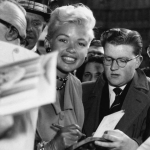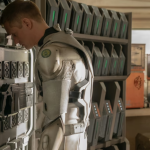Frank Sinatra was at a yacht club in San Pedro, California, on August 5, 1945, the day before the end of the world. He is said to have saved a 3-year-old boy from drowning there.
The father of relativity, Albert Einstein, was lodging in Cabin No. 6 at the Knollwood Club on Lower Saranac Lake in the Adirondacks on the opposite side of the nation. A 10-year-old boy once saved Einstein from drowning because he couldn’t swim a stroke (in reverse Sinatra).
When they awoke on the morning of August 6th, neither of them realized that it was 8:15 a.m. The first atomic bomb, known as “Little Boy,” was dropped on the city of Hiroshima on Japan Standard Time, destroying any standing buildings and killing nearly 80,000 people.
In his 1963 book Cat’s Cradle, Kurt Vonnegut referred to it as “the day the world ended.” Vonnegut had been in the U.S. army during World War II and was among the few survivors of another American attack: the firebombing of Dresden, Germany, which destroyed the town, once called “Florence on the Elbe.”
Vonnegut later wrote in Slaughterhouse-Five, the book that fictionalized his experience, that “the sky was black with smoke. The sun was a tiny, irate pinhead.” Now, Dresden was just minerals, like the moon. The stones were hot. Everyone else in the neighborhood was dead.
According to some estimates, the atomic bomb dropped on Hiroshima killed up to 146,000 people, including those who would later die from injuries, burns, and long-term radiation poisoning.
I say kids because Colonel Paul Tibbets, the mission commander, was thirty years old. The co-pilot, Robert A. Lewis, was 27 years old. The bombardier, Thomas Ferebee, was twenty-six. Theodore “Dutch” Van Kirk, the navigator, was twenty-four.
President Harry Truman was returning from a conference in Potsdam, Germany, after that nation’s surrender, on the USS Augusta at the time. Truman’s lunch was interrupted by the ship’s captain, who informed him of the impending attack.
That afternoon, Truman went to a boxing and entertainment program on the well deck. The orchestra of the ship performed, but the boxing ended abruptly when the ring posts collapsed and a spectator was slightly hurt. That was the character of human misery at the time.
Vonnegut’s fourth book was Cat’s Cradle. He had begun it almost ten years prior, at the age of thirty-one in 1954. It tells the tale of Jonah, a journalist who decides to write a book about the activities of famous people on the day of the bombing of Hiroshima.
Jonah locates the three surviving descendants of Dr. Felix Hoenikker, one of the alleged fathers of the atomic bomb, in the book. The world could end because of a substance called Ice 9, which Hoenikker, an eccentric scientist, created after leaving a tip for his wife by his coffee cup.
When Cat’s Cradle was published, it had about as much of an impact on popular culture as Vonnegut’s earlier works—that is to say, not very much. More than a decade had passed since the publication of his first book, Player Piano, with little praise, and Vonnegut was struggling to support his expanding family.
Prior to the market softening after the war, he had earned a respectable living from writing short stories. Since then, he had worked as a publicist for General Electric and as an English teacher at a school for mischievous boys. In a moment of hope, he even opened a doomed Saab dealership on Cape Cod.
Desperate would be a fitting word to characterize Vonnegut’s mental state during those years. He had no idea that he would become one of the most well-known authors in the world after Slaughterhouse-Five was published in 1969.
The fact that World War II would be the final conflict of what historians refer to as the Industrial Age was also unknown to Vonnegut. Steam-powered devices had transformed human enterprise in the 19th century. Then, as physicists like Einstein and his successors illuminated the very fabric of the universe, a wave of unprecedented invention followed.
This wave included the development of electricity, the telegraph, telephone, automobile, and airplane. Many of those same physicists would go on to work on the Manhattan Project, which used the atom’s power to create the first atomic weapon.
Little Boy was, in some respects, the pinnacle of the Industrial Age, which came to an end a few years later. What took its place? Naturally, the Information Age came after the Atomic Age in the 1970s.
“Whatever they call the age you live in is actually the name of the weapon they’re using to try to kill you,” Vonnegut might say if he were still with us today.
Kurt Vonnegut left Cornell University and joined the Army in 1943, two years prior to the bombing of Hiroshima. He was twenty years old.
He was sent to Europe as a scout after learning how to fire howitzers from the Army. Vonnegut surprised his mother, Edith, by returning home for Mother’s Day 1944 before departing.
Vonnegut was shocked when Edith killed herself in retaliation. She took sleeping pills that Saturday night while he lay in another room, unconscious.
Seven months later, Private First Class Vonnegut was with the 106th Infantry Division’s 423rd Infantry Regiment, crossing the beach at Le Havre. They marched to Belgium and positioned themselves close to the town of St. Vith in the Ardennes Forest.
Death was everywhere, and it was one of the coldest winters ever recorded. The Germans launched their attack on December 16. The battle that followed got its name because of the bulge in the line caused by inexperienced American troops holding the front buckling.
Approximately 80,000 American soldiers had been killed or injured by the time it ended. Vonnegut, however, did not finish. He barely survived the three days. His regiment was forced to surrender after being cut off and outnumbered; Vonnegut and over 6,000 other soldiers were taken prisoner.
His friend Bernard O’Hare yelled, “Nein scheissen!” as the Germans moved forward. to the German troops that were approaching. This did not imply, “Avoid shooting!” as he pondered. Instead, he screamed, “Don’t shit!”
Vonnegut and thousands of other American prisoners of war were crammed into boxcars following a protracted forced march. The soldiers were packed so close together that they had to stand, and the dark cars stank of cow feces.
The loading process took two days. Later, Vonnegut described how the Royal Air Force attacked the unmarked German train eighteen hours after they left.
The day was Christmas Eve. Dozens of American prisoners were killed by Allied planes as they were sprayed by RAF fighters and bombs dropped all around them. Vonnegut was still alive in spite of everything.
Robert Serber, a Los Alamos physicist who contributed to the bomb’s design, came up with the moniker Little Boy. It seems appropriate for a weapon dropped by kids from a plane named after Enola Gay, the pilot’s mother.
Made of riveted steel and wires, “the gadget,” as the scientists called it, was a plug-ugly sumbitch that was ten feet long and nearly ten thousand pounds in weight. Nothing like today’s shiny, streamlined technology.
As you can see, Little Boy was a gun-type bomb, and it detonated by launching a uranium “bullet” into a uranium target. Together, the projectile and target created a supercritical mass that could support a swift nuclear chain reaction.
“Massive explosion” is what scientists call it, and boy howdy, was it. It is challenging to characterize fission reactions using our human sense of time because they happen so quickly.
A fireball of several million degrees was created within a millionth of a second of the uranium bullet striking its target. This created a shock wave that pushed the atmosphere at supersonic speeds and traveled outward from the hypocenter at a speed of two miles per second.
The shock wave’s blast was equivalent to fifteen kilotons of TNT. Birds were ignited in midair as the flaming shock wave smashed everything in its path.
Thermal radiation, which included gamma and infrared rays that flashed through clothing and burned textile patterns into the victims’ skin, caused severe burns up to a mile away. This accounted for about one-third of the bomb’s energy.
About 80,000 people were turned to ash and 4.4 square miles of the city were destroyed in the time it takes to say “boom.”
The first Western journalist to arrive in Hiroshima following the bombing was Wilfred Burchett. He wrote, “Hiroshima does not look like a bombed city,” while perched on a piece of debris on September 2.
To be clear, a steamroller was an Industrial Age device used to compact dirt and gravel to create smooth surfaces on which cars could drive. It appears as though a monstrous steamroller had run over it and crushed it to nothing.
Thus, the world ended, at least in theory if not in reality.
It took hundreds of bombs dropped over several hours to completely destroy Dresden. It only took one to destroy Hiroshima.
This is what progress looks like, a cynical man might say.
“The crisis of our time can be summed up in a single sentence,” wrote Hungarian British author and journalist Arthur Koestler in his 1967 collection of essays about the Atomic Age, The Ghost in the Machine.
Throughout human history, children have adopted a rule of engagement known as “not in the face.” Consider it the first Geneva Convention.
From the beginning of consciousness until the middle of our century, man had to live with the prospect of his death as an individual; since Hiroshima, mankind as a whole has had to live with the prospect of its extinction as a biological species.
The offender faces severe consequences for breaking the not-in-the-face rule. It’s a war act. I get to hit you in the face now, or worse. To correct the imbalance of power and teach you a lesson, I might even kick you in the balls.
Perhaps I should make hitting me in the face so expensive that you won’t try again. Hiroshima was the kick in the balls that put an end to all future wars, if Pearl Harbor was an unprovoked face punch.
That kick was made possible by Industrial Age scientists.
After the war, Vonnegut had a tumultuous relationship with his own children.
When Vonnegut’s brother-in-law, Jim, died in a train derailment in 1958—his commuter train launching itself from the Newark Bay Bridge into Newark Bay—there would be seven of them—three biological and four of his sister’s boys—who had moved in with him and his wife, Jane.
Alice, Vonnegut’s sister, passed away from breast cancer two days later. That’s how it is.
On Mother’s Day 1944, Alice had woken Vonnegut up to inform him that their mother had passed away.
“I had never told her so, but she was the person I had always written for,” Vonnegut wrote in Slapstick, referring to Alice as his muse. She held the key to any artistic coherence I had ever attained.
All of a sudden, the house was packed with kids ranging in age from two to fourteen.
Vonnegut attempted—and largely failed—to write Cat’s Cradle over the course of the following five years. He was irritable due to the strain of being a writer and providing for such a large family while still dealing with the trauma of the war.
He was never a hands-on father, leaving Jane to handle the majority of the actual parenting. He would spend the day in his study, chain smoking, while the chaos of family life surrounded him. He could storm out of the room at the first sound made by the kids.
Vonnegut had grown up surrounded by math and science. He had an architect for a father. His brother would become a pioneer in the field of cloud seeding as a scientist.
However, Vonnegut’s relationship with the term “progress” was complex. He was no longer convinced that science was solely a positive force because of his wartime experience.
He felt that engineers and scientists were too preoccupied with the question, Can we do something? Instead, should we?
When he examined the Manhattan Project, he noticed this. Los Alamos scientists rarely considered the effects of dropping the bomb they were designing, even though they knew it was intended to be dropped on humans.
Victor Weisskopf, a physicist who had worked on the bomb at Los Alamos, acknowledged after the war that he was “shocked to say that few of us even thought of quitting.” It was the task’s allure.
“It was impossible to quit at that time.” He described the task as “technically sweet.” During his testimony at his post-war security clearance hearing, Robert Oppenheimer himself used this phrase.
In my opinion, when you see something technically sound, you should do it right away and only debate the best course of action after you’ve achieved technical success. That’s how the atomic bomb worked.
“Nice, nice, very nice,” as Bokonon wrote in his “53rd Calypso.” Bokonon was the fictional founder of a religion that Vonnegut invented for Cat’s Cradle, a book that was as much about war as it was about the hypocrisy of organized religion.
“All of the true things I am about to tell you are shameless lies.”
Here’s another shameless lie: The atomic bomb was dropped to save lives.
This is Bokonon’s first dictum. War inverts language, which is an ancillary effect.
You see, Los Alamos scientists cared about American lives. Therefore, rather than concentrating on the Japanese citizens who would actually perish when the bomb was dropped, they decided to concentrate on the lives they would save—the GIs who would supposedly perish in a conventional invasion.
This made it simpler to defend the morality of their behavior. They managed to keep things sweet in this way.
However, the scientists who created the atomic bomb—”what did they think would happen if they dropped it?” one survivor asked.
These are some of the events that took place.
The day gave way to night. Within a 10-mile radius, the bomb quickly destroyed 60,000 of the 90,000 buildings.
2,168 of the 2,370 physicians and nurses who worked in Hiroshima were killed or seriously injured.
As one survivor told The New York Times in 1981, “They had no hair because their hair was burned, and at a glance you couldn’t tell whether you were looking at them from in front or in back.”
This is what the atomic bomb did to survivors. They stumbled down the road, going nowhere, “like walking ghosts,” because “their skin—not only on their hands, but on their faces and bodies too—hung down.”
The majority of school-age children near ground zero were killed on impact, so the survivors were mostly adults. This is due to 8:15 a.m.
In the event of firebomb raids, such as the ones that destroyed Tokyo and numerous other Japanese cities, they had assembled outside their schools on August 6 to assist in building firebreaks to slow the spread of flames.
I wonder if they heard the distant roar of the B-29 flying overhead. Many people didn’t even look up when the Enola Gay came because an hour earlier, an air-raid siren had gone off, but no planes had arrived.
Imagine the thousands of little haircuts and gap-toothed smiles of the children of Hiroshima on that bright morning.
As they wonder what the morning snack will be, thousands of kids are attempting to be good citizens. Schoolchildren and their parents were the targets of the bomb dropped by the child pilots flying overhead.
What else should we consider? There was no actual military or technological significance to Hiroshima. The population center was selected to convey a message to the emperor.
So it goes—or, as the Hiroshima survivors used to say, “Shikata ga nai,” which roughly translates to “It can’t be helped.” This sentiment originated in the Japanese practice of Zen Buddhism, which Vonnegut might argue is an even older invented religion than Bokononism.
But what else is there to say about a world where kids throw bombs at other kids?
Vonnegut describes an argument he had with Mary, the wife of his former Army friend Bernard, in Slaughterhouse-Five. When Vonnegut informs them that he is writing a novel about the war, Mary erupts:
“You were just babies then!”
“I said,” she said. “What?”
“I said.”
“Like the ones upstairs, you were infants during the war! Frank Sinatra, John Wayne, and other glitzy, war-loving, filthy old men will play you in the movies, and you won’t write it that way, will you? We’ll see a lot more of them because war will appear so amazing. And they’ll be fought by babies like the babies upstairs.”
Later, Vonnegut reflected on Dr. Felix Hoenikker, the amoral physicist in Cat’s Cradle, saying, “What I feel about him now is that he was allowed to concentrate on one part of life more than any human being should be. He became amoral as a result of his overspecialization. This is a characteristic, not a flaw, of our Information Age.
If a scientist does this, he may unintentionally turn into a very destructive person.
If not technically adorable, what are our smartphones, tablets, and social media sites? With their amazing computing power and invisible code, they are so technologically advanced and streamlined that, as Arthur C. Clarke once stated, they are no longer able to be distinguished from magic.
And this might end up being the greatest risk. Because the Should we? question has received so little attention.
Of the Information Age (what would happen if we gave people a pocket-sized entertainment device that instantly connected them to every known truth and every known lie?), we have been caught off guard as a society.
How is it possible that even more advanced modern devices have undermined our trust in science and led to the complete rejection of expertise if the atomic bomb, riveted from steel plates and visible wires, was unquestionably evidence of the power of science?
What a blatant lie!
However, how else would one explain the way that false information propagated by our magical devices appears to be eroding people’s faith in the science that underpins them?
In short, our phones have turned into a looking glass that pulls us back into the past, just as the bomb was a machine that allowed us to see into the future.
Shikata ga nai.
Following the war, Vonnegut struggled with what he believed to be inherited depression, which was exacerbated by the trauma of war, his sister’s passing, and his mother’s suicide.
Unwilling to attribute his good fortune to God and unable to explain why he had survived when so many around him had perished, Vonnegut instead turned to the ridiculous.
You die, I live. That’s how it is.
The bomb would have fallen somewhere else if Hiroshima had been overcast that morning.
There are numerous scenarios that could have resulted in death, such as if POW Vonnegut had been pushed into a different train car, if he had chosen a different foxhole, or if the Germans hadn’t dragged him into the slaughterhouse basement when the sirens sounded.
He danced between the raindrops instead, somehow. As a result, for Vonnegut, life became the punch line and death the setup in a sort of cosmic joke about survival.
Kiyoshi Tanimoto, a Methodist minister and Hiroshima survivor, was interviewed on the American television show This Is Your Life on May 11, 1955.
He had traveled to the United States to raise funds for the Keloid Girls, also known as the Atomic Maidens, who were atomic bomb victims.
Tanimoto, in a baggy suit, sits on a sofa next to host Ralph Edwards and appears in a state of shock. Following an opening scene, the camera pans to a man’s silhouette behind a screen. He uses a microphone to speak.















